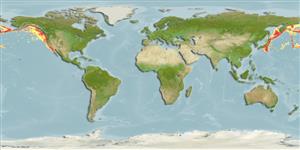Common names from other countries
>
Gadiformes (Cods) >
Macrouridae (Grenadiers or rattails)
Etymology: Coryphaenoides: Greek, koryphaina = dolphin fish + Suffix oides = similar to (Ref. 45335); acrolepis: From the Greek 'acros' meaning sharp and 'lepis' meaning scale (Ref. 6885).
More on author: Bean.
Environment: milieu / climate zone / depth range / distribution range
Sinh thái học
Biển Tầng đáy biển sâu; không di cư; Mức độ sâu 300 - 3700 m (Ref. 50550), usually 900 - 1300 m (Ref. 56476). Deep-water; 1°C - 4°C (Ref. 1371); 62°N - 28°N, 134°E - 115°W (Ref. 1371)
North Pacific: northern Japan to Okhotsk and Bering seas, south along North American coasts to northern Mexico.
Length at first maturity / Bộ gần gũi / Khối lượng (Trọng lượng) / Age
Maturity: Lm 55.5, range 46 - 65 cm
Max length : 104 cm TL con đực/không giới tính; (Ref. 56527); common length : 46.9 cm TL con đực/không giới tính; (Ref. 56476); Khối lượng cực đại được công bố: 3.0 kg (Ref. 56476); Tuổi cực đại được báo cáo: 73 các năm (Ref. 35883)
Các tia vây lưng cứng (tổng cộng) : 2; Các vây lưng mềm (tổng cộng) : 122; Tia cứng vây hậu môn: 0; Tia mềm vây hậu môn: 94. Head large, scaled completely except for a narrow ventrolateral strip on snout; eyes also large; snout short, pointed and with tubercular scales along its leading edge; chin with a small chin barbel. Body tapering to a point posteriorly from behind the insertion of the first dorsal-fin spine. Scales adherent, with 3 to 5 divergent rows of coarse spinules. Pyloric caeca 12 to 14. Overall color is gray to grayish-brown in young, turning to dark brown in adults; fins generally dark. Branchiostegal rays: 6-6 (Ref. 36385).
A benthopelagic mid-slope species, that appears to wander off slope bottoms into midwater (Ref. 1371). Adults feed on small fish, euphausiids, prawns, amphipods and cephalopods (Ref. 1371). Oviparous, with planktonic larvae (Ref. 36385).
Cohen, D.M., T. Inada, T. Iwamoto and N. Scialabba, 1990. FAO species catalogue. Vol. 10. Gadiform fishes of the world (Order Gadiformes). An annotated and illustrated catalogue of cods, hakes, grenadiers and other gadiform fishes known to date. FAO Fish. Synop. 125(10). Rome: FAO. 442 p. (Ref. 1371)
IUCN Red List Status (Ref. 130435)
CITES (Ref. 128078)
Not Evaluated
Threat to humans
Harmless
Human uses
Các nghề cá: Tính thương mại
Các công cụ
Special reports
Download XML
Các nguồn internet
Estimates based on models
Preferred temperature (Ref.
115969): 2.3 - 3.8, mean 2.4 (based on 174 cells).
Phylogenetic diversity index (Ref.
82804): PD
50 = 0.5000 [Uniqueness, from 0.5 = low to 2.0 = high].
Bayesian length-weight: a=0.00141 (0.00085 - 0.00234), b=3.19 (3.04 - 3.34), in cm Total Length, based on LWR estimates for this species & (Sub)family-body (Ref.
93245).
Mức dinh dưỡng (Ref.
69278): 3.8 ±0.54 se; based on food items.
Thích nghi nhanh (Ref.
120179): Rất thấp, thời gian nhân đôi của chủng quần tối thiểu là hơn 14 năm (K=0.02-0.04; tmax=73).
Fishing Vulnerability (Ref.
59153): Very high vulnerability (79 of 100).
